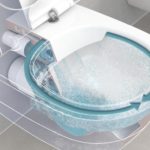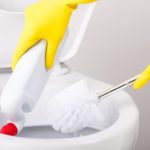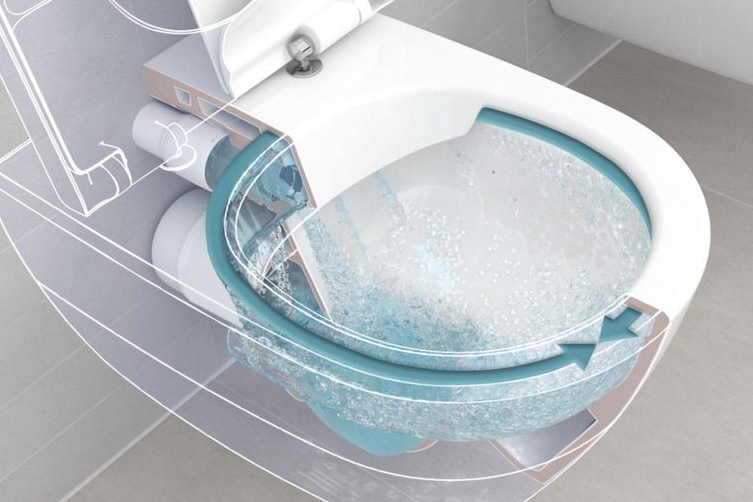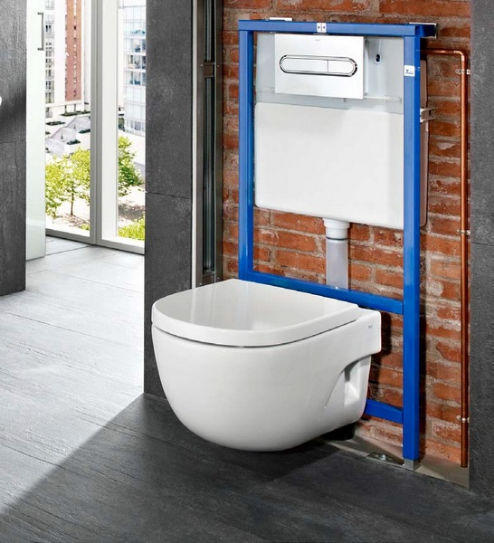How to remove rust from a toilet?
Rust in the toilet is not a very pleasant phenomenon. Even a perfectly white and new device is susceptible to this disease. But there is no need to be upset. Rust can be washed off. Moreover, so many methods have been invented today that you can experiment on the toilet and choose the most effective method for an infinitely long time, until your patience runs out. In order not to get lost in all the variety of tips, we have collected in this article proven and reliable methods for removing rust at home.
The content of the article
Why does rust appear in the toilet?
There are many reasons for this. Not in all cases this is due to the fault of the owners.
So, most often rust appears:
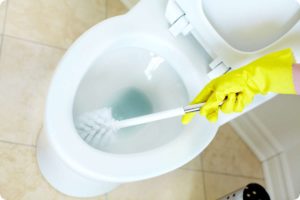 from poor water quality. The surface of the toilet quickly becomes covered with a yellow coating. By the way, other plumbing fixtures also suffer: the sink and bathtub have to be cleaned of the unpleasant tint no less often;
from poor water quality. The surface of the toilet quickly becomes covered with a yellow coating. By the way, other plumbing fixtures also suffer: the sink and bathtub have to be cleaned of the unpleasant tint no less often;- due to poor condition of water pipes. For sewerage and water supply pipes, pipes made of non-galvanized metal are used, which corrode over many years of use. Therefore, the water flows dirty, with iron impurities, which color the snow-white toilet in all shades of rusty;
- due to leaking pipes, wear of components in the tank.Bright yellow strings that stretch from the tank can be observed where the toilet or plumbing system needs repair. Even clean water flowing continuously over the same place can leave a rusty mark.;
- with improper care, in particular, the use of aggressive agents and metal brushes for washing, which damage the surface;
- due to the characteristics of the material from which the toilet is made. Porcelain and earthenware utensils are popular these days. The latter are more affordable in price, but their quality is an order of magnitude lower. Earthenware plumbing quickly loses its smoothness; cracks and chips are more likely to form on its surface, in which drops of water constantly “hold”. They lead to unpleasant rust.
Methods and means of cleaning from rusty stains
Even our grandmothers knew how to clean earthenware and porcelain surfaces from rust. Today, the industry also does not stand still: on store shelves you can see a huge number of gels, powders and sprays for cleaning the toilet.
Conventionally, all methods of cleaning plumbing fixtures are divided into two large groups:
- Traditional methods (tested over the years and new ones that have appeared more recently);
- Household chemicals (abrasive, acidic, alkaline).
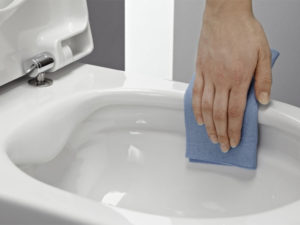 Each housewife chooses what is familiar to her. It is recommended to focus on budget, health status (for example, if you are prone to allergies, you need to use household chemicals carefully), individual preferences, material, from which the toilet is made.
Each housewife chooses what is familiar to her. It is recommended to focus on budget, health status (for example, if you are prone to allergies, you need to use household chemicals carefully), individual preferences, material, from which the toilet is made.
You will also need tools to clean the plumbing. These can be soft foam sponges, brushes and brushes with soft bristles, viscose rags.
Important! Regardless of the means, you should follow simple rules that will help you complete the job not only efficiently, but also safely:
- if the toilet is leaking, then you need to turn off the water before washing;
- Do not mix cocktails of plumbing cleaners. The chemical reaction can be completely unpredictable;
- to avoid burns, work is performed strictly with rubber gloves;
- when using household chemicals, the door to the toilet room must be kept open;
- Also, do not lean too low over the toilet during the cleaning process, as there is a risk of inhaling harmful fumes and getting a burn to the mucous membranes, an allergic reaction, or poisoning from household chemical vapors.
Traditional methods
Human imagination is capable of many things. Whatever people have come up with throughout the history of the toilet to make it white and shiny. We must pay tribute to: many folk methods are truly effective and are not inferior in cleaning properties to modern new household chemicals.
Let's look at the most popular ways to get rid of rusty stains:
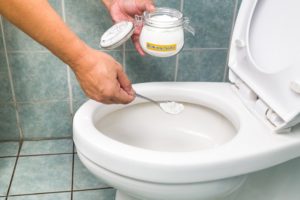 "White". This miracle remedy has been known since ancient times. It is good for its high content of chlorine, which not only removes stains, but also disinfects the surface.
"White". This miracle remedy has been known since ancient times. It is good for its high content of chlorine, which not only removes stains, but also disinfects the surface.- Toothpaste. Experienced housewives say that bleaching paste works best with rusty stains. It should be applied in a thin strip and left on the surface of the toilet for 15–30 minutes. Then rinse with water.
- Vinegar. It has been used for many years not only to remove rust, but also to clear blockages. Because This procedure is also useful for pipes. To remove rust stains, place a small cloth generously soaked in vinegar on the surface of the toilet and leave it like that for 40–60 minutes.After this, the vinegar is washed off with water; in case of heavy contamination, the surface of the toilet bowl can be additionally rubbed with a foam sponge.
- Ammonia and hydrogen peroxide. They are mixed in a ratio of 1:20. A cloth moistened with the resulting solution is applied to the rust, leaving the toilet in this form for several hours (ideally, if overnight). After the procedure, the treated surface is washed with water.
- Soda. A safe product, it can be used even by housewives who suffer from all kinds of allergic reactions. In addition, soda does not harm the delicate skin of your hands, which is certainly a good thing. To remove rust, soda is mixed with hydrogen peroxide or water to the consistency of thick sour cream. Using a toothbrush or your own fingers, apply the composition to the surface of the toilet bowl and leave until completely dry. When the soda turns into a powdery, frozen crust, it is washed off with a soft brush.
- Carbonated drinks like Coca-Cola. The method is relatively young, but popular. Cola removes even heavy dirt. To do this, just soak a rag in the drink and apply it to the toilet. After 30–60 minutes, not a trace will remain of the stains.
Household chemicals
Household chemicals are usually separated to abrasive and liquid. In turn, liquids are alkaline and acidic. All these chemical industry products have one goal - to clean the toilet bowl efficiently and quickly from any stains and contaminants. It must be said that household chemicals in most cases do an excellent job. It is important to use them correctly and strictly follow the instructions.
Gels and liquids
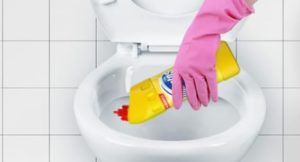 These products clean gently and do not scratch the surface of the toilet.The active substances contained in the gels penetrate the rusty coating and eliminate it. In alkaline liquid substances, the main component is sodium. They do not require additional mechanical impact on the stain and are absolutely safe for the surface of the toilet bowl.
These products clean gently and do not scratch the surface of the toilet.The active substances contained in the gels penetrate the rusty coating and eliminate it. In alkaline liquid substances, the main component is sodium. They do not require additional mechanical impact on the stain and are absolutely safe for the surface of the toilet bowl.
Alkaline agents include:
- Domestos;
- Sarma gel.
By the way! Alkaline gels are good for fresh stains. Sodium does not penetrate deep layers of dirt, so it may not cope with old rust.
Acid-based products brilliantly remove old stains. They contain acid: formic, oxalic or hydrochloric. The higher the acid concentration, the better the product will cope with rust.
Acidic agents are:
- Cilit Bang;
- Toilet duckling;
- Comet.
Acidic products are not safe. Their fumes can cause poisoning, so be sure to work with the door open.
Abrasives
These products are powders known to everyone. They remove stains using special particles and are most often universal. A jar of powder can be used to clean not only the toilet, but also the sink, bathtub, tiles on the walls, grease stains on kitchen work surfaces and even scale on the kettle.
The most popular among housewives are:
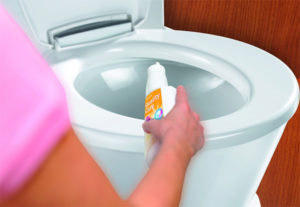 Pemolux;
Pemolux;- Sorti;
- Sarma;
- comet;
- Sanita.
These products must be used carefully. The powder may scratch the porcelain surface of the toilet.. Therefore, before applying it, it is better to stir it with water until it becomes pasty.
Important! Apply abrasives only to the damp surface of the toilet so as not to damage it.
For better cleaning, especially strong stains can be rubbed with a brush or sponge, but without fanaticism.
Powder products have serious minuses:
- they are suitable only for fresh stains (ideally clean the surface from light deposits);
- dust from the powder easily gets into the eyes or nasal mucosa (in this case, the affected areas should be rinsed with plenty of water).
Preventing rust on the surface of the toilet bowl
It is easier to prevent any disease than to treat it in a long and painful way. The same goes for stains on plumbing fixtures. Taking good care of your toilet will save you more than just money (since it will serve faithfully for many years), but also time (constant maintenance prevents the appearance of persistent stains, which means that washing the toilet will not take long).
To make the toilet happy with cleanliness and whiteness, it is important:
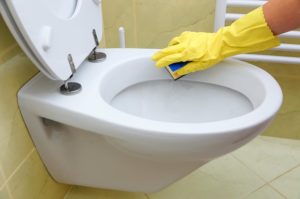 Avoid leaks and change consumables in the tank in a timely manner.
Avoid leaks and change consumables in the tank in a timely manner.- A lot of plaque that spoils the water accumulates in the tank. Therefore it is useful periodically pour vinegar into the tank or add tablets, designed specifically to protect against rust and lime deposits.
- For water pipes better install a filter. Yes, this pleasure is not cheap. But constantly replacing plumbing fixtures is more expensive.
- To prevent stains from becoming companions of the toilet bowl, you need to carry out regular inspection its surface for cracks and chips. It is difficult to remove dirt from these chips, which gradually turns into persistent rust stains.
Care Tips
You need to properly care for your plumbing:
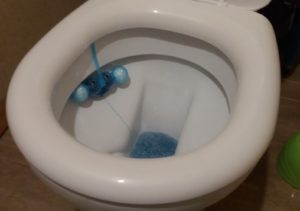 There is no need to keep the cleaning agent on the surface of the toilet longer than the time specified in the instructions.
There is no need to keep the cleaning agent on the surface of the toilet longer than the time specified in the instructions.- Don't let stains go to chance. If you are not satisfied with the results of the cleaning product, the procedure must be repeated.
- After each flush, you need to make sure that water does not drip into the toilet.
- To prevent rust stains and unpleasant odors from appearing on the toilet rim, you need to attach a special product.
- If you decide to replace the toilet, then it is better to choose a porcelain model. This material washes well and lasts a long time.
The toilet is that item in the house without which life is impossible. That is why you need to take care of it and avoid disgusting rusty smudges and stains. Then the entire toilet room will look clean and tidy.


